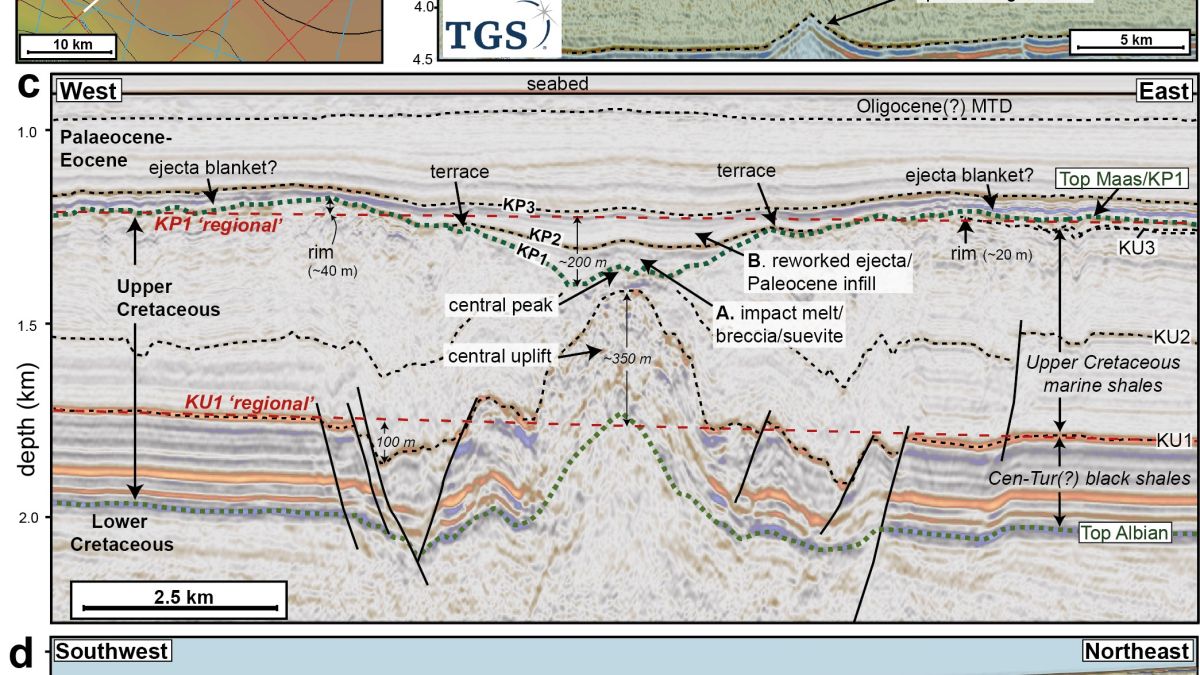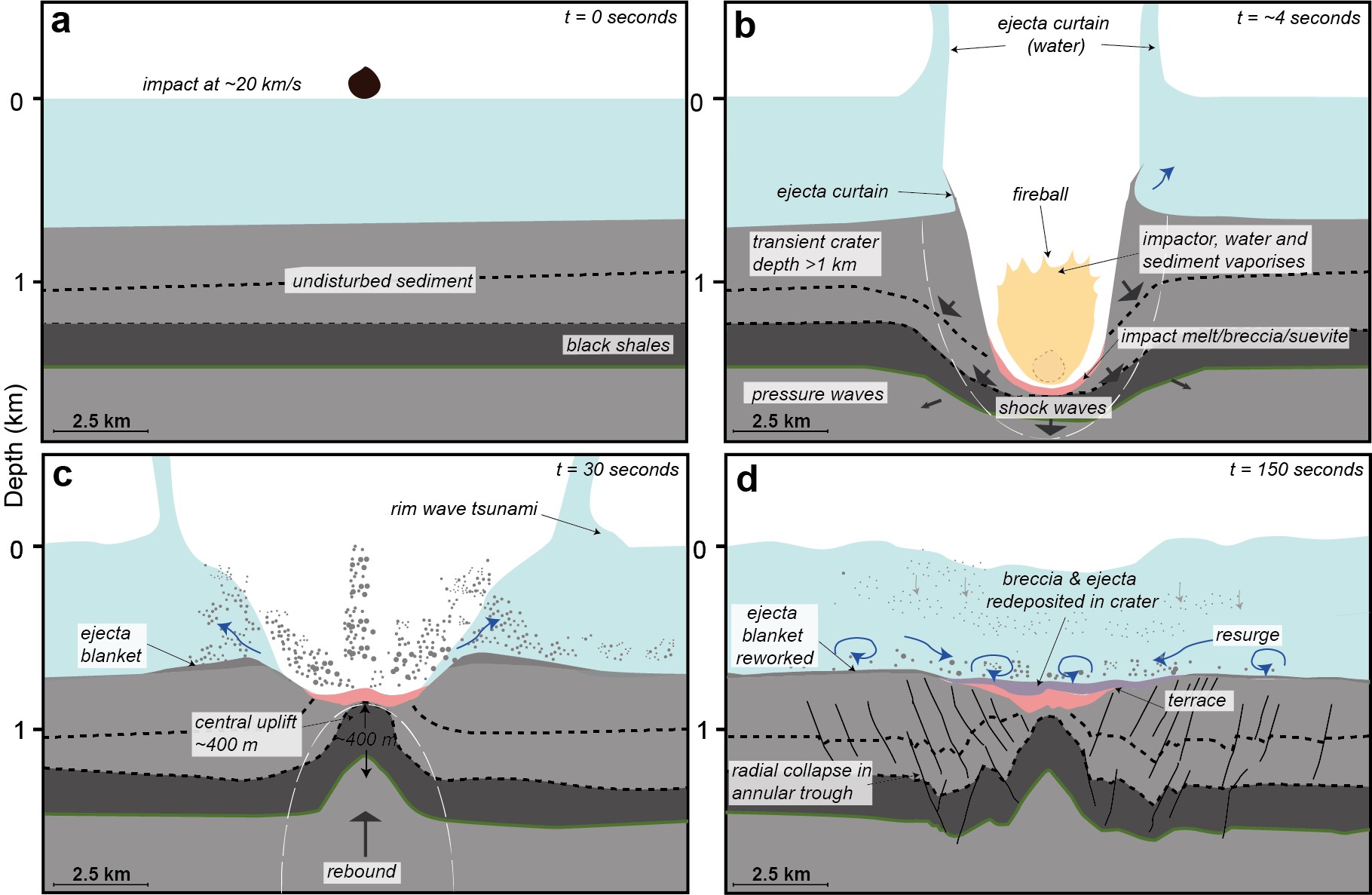Did a second killer asteroid finish the dinosaurs off? Crater in West Africa hints yes.
The crater dates to around 66 million years ago, but may or may not have been related to the dino-killing impact.

A likely asteroid impact crater from the latter days of the dinosaurs has been discovered off the coast of West Africa, raising questions about whether the asteroid that wiped out the dinos may have had a smaller sibling that struck around the same time.
The crater, hidden under about 3,000 feet (900 meters) of water and 1,300 feet (400 m) of sediment, hasn't been directly studied yet; it's only been detected in reconstructions of the ocean bed made using seismic waves. To prove beyond a shadow of a doubt that the crater is indeed from an asteroid, scientists will need to drill into the structure and find minerals shocked by extreme heat and pressure. But the crater's shape does point to an extraterrestrial origin, said David Kring, principal scientist at the Lunar and Planetary Institute who was not involved in the current study but was one of the discoverers of the Chicxulub impact site, the crater left by the asteroid that killed the nonavian dinosaurs about 66 million years ago.
"I have to congratulate the team for finding what looks like a probable impact crater," Kring told Live Science. "That's very important, because we have so few impact craters preserved on the Earth. Every single one that we can find provides a new window, new insights into the geological processes that shape them and their effects on biological evolution of Earth."
The new crater was formed very close in time to the Chicxulub impact, raising the possibility that the two may be related.
Related: 10 Earth impact craters you must see
A striking find
When Uisdean Nicholson, a geologist at Heriot Watt University in the U.K., and his team started poring through seismic data from the West Coast of Africa, they weren't looking for signs of space rocks. The goal, Nicholson told Live Science, was to study the tectonics that were driving South America and Africa apart 100 million years ago.
The seismic data are acquired by sending vibrations from a trawling ship toward the seafloor and recording the waves that bounce back. The result is a set of squiggles that shows the structure of the subsurface. To the researchers' surprise, on the seafloor about 250 miles (400 kilometers) from the coast of Guinea and Guinea -Bissau, they found evidence of an odd divot in the rock layers.
Breaking space news, the latest updates on rocket launches, skywatching events and more!
"The crater is very striking, and unlike anything that I had ever seen before," Nicholson said.
What the researchers were seeing was a roughly circular or elliptical hole around 5.3 miles (8.5 km) from rim to rim and up to 131 feet (40 m) from floor to rim. The crater's edge revealed signs of faulting and rock deformation, and perhaps even material thrown out of the main crater that landed around it after the impact. One of the telltale features was a structure under the crater floor where the rock layers were raised above their surroundings. This "central uplift" happens after impacts where the shock pressure is high enough to force the grains in the rock to act like a fluid, Nicholson said; the rock essentially sloshes apart, splashes back together and is frozen in that configuration ever after.
Intense impact
The researchers dubbed the structure the Nadir crater after a nearby seamount and reported their findings today (Aug. 17) in the journal Science Advances.
The crater would have been caused by an asteroid that was 1,200 feet (400 m) wide — roughly the height of the Empire State Building. It would have been a bad day to be a fish. The asteroid hit the ocean bed with the power of 5,000 megatons of TNT, the researchers calculated, and it would have produced a fireball 6.2 miles (10 km) wide. This would have instantly vaporized massive amounts of water and rock. The impact would have created a magnitude-7 earthquake that could have kicked off a series of submarine landslides, all of which would have created some serious waves. The splash at the impact site would have towered at least 1.2 miles (2 km), Nicholson said, and the waves that reached the West African coastline may have been 60 miles (100 km) high. The South American coast, 620 miles (1,000 km) away at the time, would have seen 16-foot-high (5 m) tsunamis.
Despite this short-term devastation, Kring said, marine life would have likely rebounded quickly. In a similar marine crater, now on dry land in Nevada, researchers have found that the sediments right on top of the crater show colonization by new life shortly after the impact, he said.
A dino-killing barrage?
Based on the rock layers in and around the crater, Nicholson and his team found that it is about 66 million years old, about the same age as the impact that created the Chicxulub crater off the modern-day Yucatán Peninsula, ending the age of the dinosaurs. Chicxulub was created by an asteroid about 6.2 miles in diameter — 25 times bigger than the one that probably struck off of West Africa. The similarity in timelines raises the question of whether the two were related.
It's tough to say. The seismic data allow Nicholson and his team to estimate the new crater's age to within only about 800,000 years, so it's possible that the impacts occurred quite far apart in time and had nothing to do with each other. Because craters on Earth are so often eroded or destroyed by tectonics, it's easy to forget that impacts are relatively common, geologically speaking, Kring said.
There are a couple of scenarios in which the Chicxulub crater and the Nadir crater could be connected, however. The dinosaur-killing asteroid may have broken up near Earth and could have hit the planet in a couple of volleys, hours or a few days apart, Nicholson said. Or, the two space rocks could have been from the same parent asteroid that broke apart in the asteroid belt and pummeled Earth with a cluster of impacts over a million or a couple of million years.
Getting any further details on the Nadir crater would require drilling into the crater floor and pulling up rock samples, which might show impact-shocked minerals that could be analyzed to get a more precise date. Tiny asteroid fragments might still be embedded in the crater. Nicholson said he and his team have submitted a drilling proposal to the International Ocean Discovery Program, but even if the effort is approved and funded, it won't happen until 2024 or 2025 at the earliest.
Undersea drilling is complicated and expensive. It took a decade for scientists to conduct marine drilling at the Chicxulub impact site after it was identified in 1991, and only two drilling expeditions have happened in 30 years. Nevertheless, Kring said, the Nadir crater is a tempting spot for exploration.
"If money was available, drilling into that structure would be a lot of fun," he said.
Originally published on Live Science.

Stephanie Pappas is a contributing writer for Space.com sister site Live Science, covering topics ranging from geoscience to archaeology to the human brain and behavior. She was previously a senior writer for Live Science but is now a freelancer based in Denver, Colorado, and regularly contributes to Scientific American and The Monitor, the monthly magazine of the American Psychological Association. Stephanie received a bachelor's degree in psychology from the University of South Carolina and a graduate certificate in science communication from the University of California, Santa Cruz.


